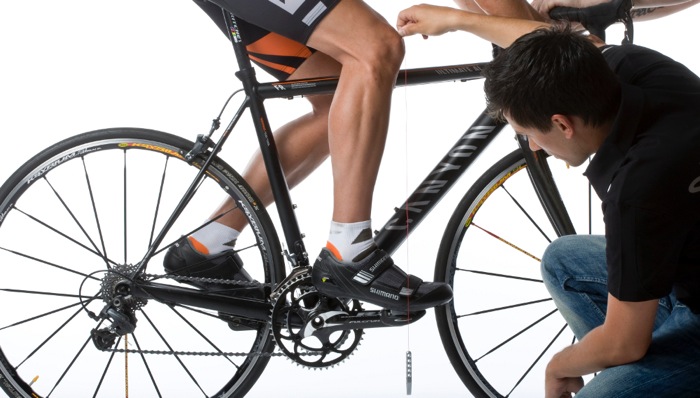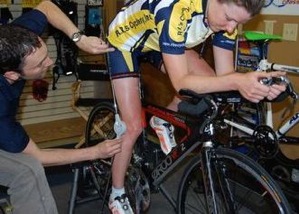
The bike seat is such a fundamental part of cycling that you would think there'd be a uniform approach to setting it at the correct height. But just like all seemingly simple tasks in life, there are far too many ways to skin a cat. Let's take a look at just a few methods you can try - and then once we've trained you up, we'll finish it off by saying "forget everything we've taught you! Just go see your local bike shop so it can be done professionally!" Now go get your bike and let's get into it, or onto it...
YOU WILL NEED
- 1 x tape measure
- 1 x road bike
- 1 x book or ruler
- 1 x multi tool or allen keys
1. THE HEEL METHOD
The method everyone knows, yet all seemingly manage to get it wrong. The method with absolutely no scientific backing, but quite possibly the most common way to set someones saddle height. Place the pedal at the 6 o'clock position before placing your heel on the pedal. Set the saddle height so that your heel just skims over the pedal with your leg straight. Be sure to keep your pelvis horizontal when doing this, to ensure some degree of accuracy.
If you ever pop in to a local bike shop for some test rides, this method will likely be used. It is by no means accurate, but it's good enough to allow you to cruise around the block a few times.
2. THE 109% METHOD
In 1967 two gentlemen named Hamley and Thomas sat down to write a paper. Not just any paper, but one on the ideal saddle height. After much deliberation, they settled on the following: 'The ideal saddle height is achieved when the saddle is positioned at 109% of your inseam length' (when measuring from the pedal axle to the top of the seat).
Your inseam in this method and for any bike fit is basically the length from your crotch to the floor. To calculate your inseam length, take a thick book or a ruler and slide it between your legs. Push it firmly up into your crotch area, and keep it level. Measure with a tape, the distance from this horizontal point to the ground. This is your inseam length.
It's best to allow someone else to do the measuring for you, to ensure a greater degree of accuracy. This method is so popular that many top end coaches and cyclists swear by it despite the availability of more scientifically accurate methods.
3. THE HOLMES METHOD
Not created by Sherlock himself, but close enough. The Holmes Method takes the 109% method just a little bit further, by means of a goniometer. A goniometer is a hinged plastic tool which shows the angle of bend in your knee. When seated in the previously mentioned position, pedal at 6 o'clock, foot on pedal, you should have a knee bend angle of 25-35 degrees. Those suffering the effects of old age or lack of flexibility would aim at 25 degrees, while the competitive lot would aim at 35 degrees of bend. If your kitchen drawers don't contain a goniometer, you should be able to pick one up at some medical suppliers. (or alternatively a couple of plastic rulers, a protractor and a very steady hand)
WHY VISIT YOUR LOCAL BIKE SHOP? We've listed three methods in which to achieve this one simple task - but we haven't even touched on the following topics; seat tilt, seat distance fore and aft, seat width, seat contour and finally seat cutaways... We don't want to add chapters of information here, which is why we can safely say it's best to visit your local bike shop!
PROFESSIONAL FIT

When you visit your local bike shop you'll likely be on the receiving end of some expert knowledge and a whole heap of bike fitting tools. There are many ways in which industry experts have integrated technology into achieving the perfect fit; from computer assisted bike fits through to those on 'Rig Bikes'. Rig bikes are designed to be infinitely adjustable before measurements are finally transferred from the rig to your actual bike...
The methods used in a professional environment far exceed what could be done at home with a ruler and a tape measure, which is why it's worth getting it done properly.
The best part about forking out the extra cash to get a professional bike fit done is that you should have the option of returning to the bike shop to express your dissatisfaction or lack of comfort - a further adjustment might be in order which you may receive free of charge.
The local bike shop will also have an array of seats and handlebars to further adjust your setup. Take full advantage of these options, as it's the perfect opportunity to not only set your seat height, but also receive a full blown bike fitting. After all, your overall riding comfort is dependent on all aspects of your bike, not just your seat height.



